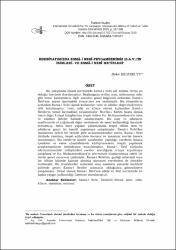Edebiyatımızda Esmâ-İ Nebî-Peygamberimiz (S.A.V.)’İn İsimleri- ve Esmâ-İ Nebî Metinleri
Özet
Bu çalışmada klâsik metinlerde Esmâ-i Nebi adı verilen türün ne olduğu üzerinde durulmuştur. Başlangıçta verilen isim, müsemma, sıfat gibi temel kavramlarla ilgili sunulan genel bilgilerin ardından Esmâ-i Nebî'nin sayısı üzerindeki rivayetlere yer verilmiştir. Bu rivayetlerin ardından Esmâ-i Nebî olarak kullanılan isim ve sıfatlar değerlendirmeye tâbi tutulmuştur. İsim, sıfat ve künye olarak kullanılan Esmâ-i Nebîlerin temel kaynakları sıralanmıştır. Kur'ân-ı Kerîm başta olmak üzere diğer kutsal kitaplardan tespit edilen Hz. Muhammed(sav)'in isim ve sıfatları listeler halinde sıralanmıştır. Bu isim ve sıfatların çeşitlenerek ve çoğalarak diğer metinlerde de nasıl kullanıldığı üzerinde durulmuş, daha önce yapılan çalışmalarda tespit edilen isim ve sıfatların genel bir tasnifi yapılmaya çalışılmıştır. Esmâ-i Nebî'den bazılarının belirli bir tasnife göre sıralanmasından sonra, Esmâ-i Nebî türünde yazılmış, tespit edilebilen mensur ve manzum eserler kısaca tanıtılmıştır. Bu eserlerin kimler tarafından yazıldığı, eserlerin kısaca içerikleri ve esere ulaşılabilecek kütüphanelerin tespiti yapılarak araştırmacıların istifadesine sunulmuştur. Esmâ-i Nebî türünün edebiyatımızdaki izdüşümleri eserler aracılığıyla ortaya koyulmaya çalışılmış ve Hz. Muhammed(sav)'in çevresinde oluşturulmuş edebî bir türün genel çerçevesi çizilmiştir. Esmâ-i Nebî'nin geçtiği müstakil veya bir bölüm hâlinde kaleme alınmış manzum eserlerden de örnekler verilmiştir. Bu örneklerden müstakil olan eserlerin yanında muhtelif şiirlerde geçen Esmâ-i Nebîler mümkün olduğunca gösterilmeye çalışılmıştır. Genel olarak Esmâ-i Nebî'nin edebî ve dinî metinlerde ne kadar yaygın kullanıldığı üzerinde durulmuştur Introduction and the Aim of the Study This paper aims to explain a special kind of literary work called Esmâ-i Nebî-The Names of the Prophet (Hz.Muhammed(sav)) in classical scripts. After giving brief information about basic concepts like names, denominations and attributes, the reports about the number of Esmâ-i Nebî-The Names of the Prophet are introduced. Giving the reports, names and attributes that are used as the Names of the Prophet are examined. The basic sources of Esmâ-i Nebî-The Names of the Prophet which are used as names, attributes and kunya(name tag) are listed. It is emphasized on how these names and adjectives are used in various kinds of scripts by becoming diversified and reproduced, and it is tried to make a general classification of the names and attributes that are identified from the previous studies. After ordering Esmâ-i Nebî-The Names of the Prophet according to a certain classification, the two literary types, namely, prose and poetry which are identified to have been written in the form of Esmâ-i Nebî-The Names of the Prophet are introduced. Study Method Study design of this research is document analysis. Within this design, firstly by using the keywords “Esmâ-i Nebî, İsim, Esmâ, Sıfat, Nebi, Künye”, the literary works that will be used in the study are found on online database called yazmalar.gov.tr and some published books about Esmâ-i Nebî is also used. Findings and Discussion By identifying the authors, short descriptions of the works and the libraries in which these works are available, this information is presented. The projection of the literary work, Esmâ-i Nebî-The Names of the Prophet, is tried to be revealed with the works; and a general framework of a literary kind which is formed in the circle of Hz. Muhammed(sav) is tried to be built. Some additional examples from the poetry which is written either separately or as a chapter in a work and which includes Esmâ-i Nebî-The Names of the Prophet are given. Esmâ- i Nebî-The Names of the Prophet that are found in the various poems besides the seperate works from these examples are tried to be presented as many as possible. Generally, how frequently Esmâ-i Nebî-The Names of the Prophet are used in literary and religious scripts is emphasized. In addition to all the findings, it can be commented that Esmâ-i Nebî is a broad literary type on the contrary to the general view and it could be found in so many texts. Conclusions and Suggestions Dependance and affection to Seyyidü’l-Kevneyn (s.a.v.) who is the most superior servant in the creatures of Cenâb-ı Hakk is necessary for strong faith in Islam. It is confirmed in the verses of Kor’ân-ı Kerîm that happiness of both finite world and hereafter is dependant on this fact. Muslims that are concious of this necessity put into words their dependance and affection to Resûl-i Müctebâ(a.s.m.). The most apparent epiphany of this situation can be seen primarily in “Nâ’t” that Edebiyatımızda Esmâ-i Nebî-Peygamberimiz (s.a.v.)’in İsimleri- ve Esmâ-i… 169 is a seperate field of study in Turkish Literature per se, besides in all kinds of written scripts. In this article about Esmâ-i Nebî on which there are not adequate studies, to make a comprehensive evaluation of the topic that is dealt with only limited aspects in the literature it is necessary to make an overall investigation of Esmâ-i Nebî by integrating all samples of Turkish poems and prose besides the literary works of Islamic civilization. Publication of the seperate poems and proses about the subject and preparing an encyclopaedic dictionary that is comprised of scripts including all the names will illuminate the subject more clearly.
Kaynak
Turkish Studies (Elektronik)Cilt
10Sayı
4Bağlantı
http://www.trdizin.gov.tr/publication/paper/detail/TWpVMk9EUXhNUT09https://hdl.handle.net/11421/14269


















